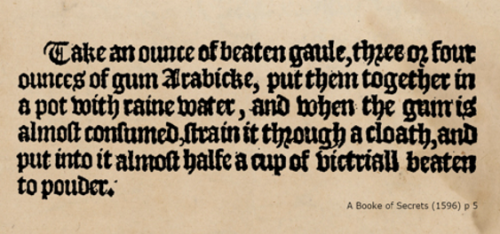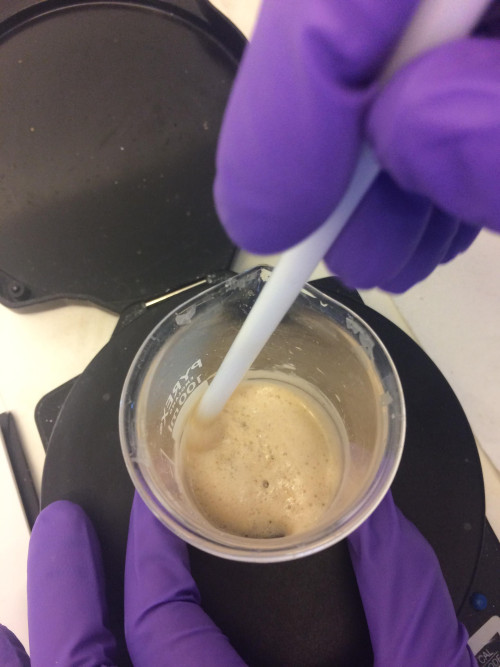Iron gall ink in the Edward Thomas manuscripts and its conservation at Glamorgan Archives
6 May 2017
Dating back to the 1st century AD and used all the way until the 19th century, iron gall ink was a common writing ink throughout Europe. It is made from iron sulphates, gum, tannins extracted from galls (generally oak tree galls), and water. There are different recipes and methods found throughout history to make iron gall ink, and some even include using wine.
So, one of the problems with this historic ink is that the degradation process of it can be detrimental to the paper or work of art it has been used for.
Excess iron (II) sulphates in the ink accelerate the oxidation process in the paper or parchment due to their reaction with atmospheric oxygen. There are three signs of degradation:
- Haloing: When there is a faint spreading of the ink.
- Burnthrough: When the ink becomes increasingly visible on the reverse of the page.
- Lacing: The inked area is so weak and friable that it causes the paper to crack and eventually fall out. This is possibly the most detrimental.

Luckily, none of the manuscripts from the Edward Thomas collection had lacing. They, however did have a slight haloing. In order to test the paper for iron gall ink, we dipped an indicator paper impregnated with bathophenanthroleine into deionised water and spot tested on an appropriate area. The bathophenanthroleine reacts with ferrous ions to form a pink complex.
Many of the Edward Thomas notebooks tested positive for iron gall ink, meaning that none of the papers could be treated with water because the ferrous ions could spread, causing further degradation. Luckily for us, in a paper written in 1995, Neeval suggested a calcium phytate aqueous treatment, where the phytate chelates (bonds) with the Iron (II) ions. It does not break down Iron (III) because it is a stable molecule, so that means the ink doesn’t fade. However, this treatment strategy has been met with some challenges because it is highly interventive, and there have been many international projects looking into the treatment of iron gall ink with calcium phytate. (Kolar et al. 2005, Kolbe 2004, Tse et al., 2005, Zappala and De Stefani 2005, Botti et al. 2005, Hofmann et al. 2004, Jembrih-Simbürger et al. 2004, Reissland and de Groot 1999.)

Looking at the alternatives, this is the most effective aqueous method of prolonging iron gall ink’s life time with minimal side effects. So, it was agreed that treating the notebooks in question with a calcium phytate bath was the best step forward to prevent further damage due to iron gall ink.
It is with thanks to the National Manuscript Conservation Trust and the Glamorgan Archives that the Edward Thomas manuscripts housed at Cardiff University’s Special Collections and Archives can be treated and conserved accordingly. In the same breath, it has served as an important learning tool for myself as a conservation student.

The BBC has a great clip about Iron Gall Ink: http://www.bbc.co.uk/programmes/p033dbrb in BBC Four’s documentary Oak Tree: Nature’s Greatest Survivor. The full programme can be purchased from the BBC Store.
References:
Neevel, J. (2009). Application Issues of the Bathophenanthroline Test for Iron(II) Ions. Restaurator 30, pp.3–15.
http://www.averybazemore.com/wp-content/uploads/2016/09/Bazemore_Avery_MA_thesis_16092016.pdf
https://irongallink.org/igi_index888e.html
This blog was originally posted on the Cardiff University Special Collections and Archives blog
- March 2024 (1)
- December 2023 (1)
- November 2023 (2)
- March 2023 (2)
- January 2023 (6)
- November 2022 (1)
- October 2022 (1)
- June 2022 (6)
- January 2022 (8)
- March 2021 (2)
- January 2021 (3)
- June 2020 (1)
- May 2020 (1)
- April 2020 (1)
- March 2020 (4)
- February 2020 (3)
- January 2020 (5)
- November 2019 (1)
- October 2019 (1)
- June 2019 (1)
- April 2019 (2)
- March 2019 (1)
- January 2019 (1)
- August 2018 (2)
- July 2018 (5)
- June 2018 (2)
- May 2018 (3)
- March 2018 (1)
- February 2018 (3)
- January 2018 (1)
- December 2017 (1)
- October 2017 (4)
- September 2017 (1)
- August 2017 (2)
- July 2017 (1)
- June 2017 (3)
- May 2017 (1)
- March 2017 (2)
- February 2017 (1)
- January 2017 (5)
- December 2016 (2)
- November 2016 (2)
- June 2016 (1)
- March 2016 (1)
- December 2015 (1)
- July 2014 (1)
- February 2014 (1)
- January 2014 (4)